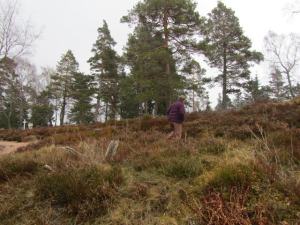One hundred years ago this October the battered hillsides of Le Linge ceased to be an actively contested battleground and hardened into an entrenched stalemate which lasted until November 11, 1918. From July 20 to October 15, 1915, German troops held the high ground while French soldiers advanced uphill toward them to defend their towns in the valley below.

During the preceding months the Germans had occupied the ridge, constructing a network of fortified tunnels and trenches partway down the mountainside. The French soldiers working their way uphill were unable to break the line. In spite of the heavy fighting and the chilling onset of an early winter, they dug trenches facing the German lines. Unable to gain ground, the soldiers faced each other, sometimes only yards apart.

The casualties of the first three months were especially horrendous, amidst the use of grenades, flame-throwers, and gas, resulting in 17,000 dead by mid-October. Ten thousand of these were French soldiers, many of whom had not yet reached their 21st birthday.
The Le Linge Memorial commemorates the soldiers of both sides. The map on the right shows the network of German trenches on the right in light blue with their fortifications and bunkers. The dark blue vertical line on the left marks the French main line with a series of short attack trenches almost reaching the German lines.
Today a portion of this battlefield is preserved, not only as a memorial, but as a cemetery for the fallen on both sides. Crosses stand here and there across the mountainside, identifying the remains of soldiers, white for French, brown for German. Instead of a name, the inscription gives a nationality. Instead of a birth date, the only exact date known is the day the remains were found. Some are surprisingly recent. “Here on May 4, 2010,” reads one brown cross “was found an unknown German soldier.” The date of death is always the same: “fallen in 1915,” the year this verdant forest in the mountains of the Vosges became a battlefield.

Le Linge is a place where you can stand in the trenches, walk through the woods, and remember the hardships, misery, and courage of the Western Front. “My dear father, dear brothers and sisters, dear grandmother, dear family,” wrote one soldier in August, 1915, “Excuse the letter that I am writing to you and the pain I am going to cause you. When you read this, I will be no more. I have done my duty as a Frenchman and a soldier. Excuse the grief that I cause to you, but consider that my sacrifice will have served the liberation of our country.”
Before walking in the battlefield itself, be sure to visit The Memorial Museum at Le Linge to get a better understanding of the context of the site. Watch the film that portrays the surrounding areas and the battle conditions, and look at the maps, photographs, letters, uniforms, and personal belongings of the men who fought and died there. If the First World War seems distant, Le Linge makes it real.

If you have a chance to go to France, be sure to visit Alsace. After sightseeing in picturesque Strassbourg, with its Gothic cathedral, wonderful astronomical clock, and historic old town, spend a few days exploring the countryside. Enjoy fine wines, pfannkuchen, and hiking in the Vosges, then drive through Colmar and Munster, and don’t forget to linger awhile in the battlefield of Le Linge.
See also:
The Memorial Museum Website at: http://www.linge1915.com/en/home/
Battles of the Western Front at http://www.greatwar.co.uk/battles/
A visual tour of the Le Linge battlefield and memorial at https://www.youtube.com/watch?v=7VItWYc9MLM
I’ll always remember the presentation you did on World War I. It was really eye opening.
Reblogged this on First Night History.
Thank you!
Their courage and their selflessness is a model for us all.